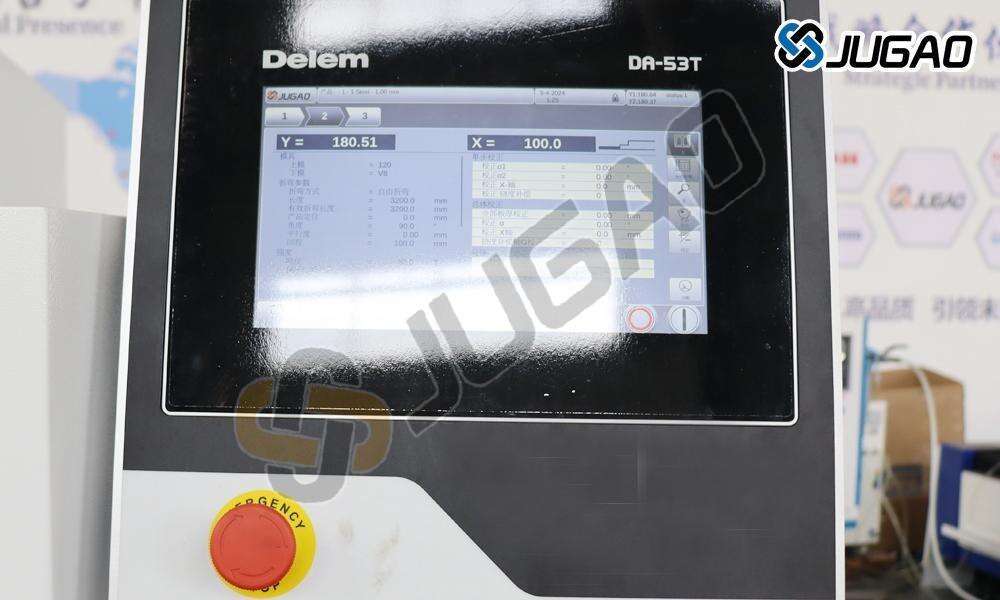دليل تشغيل نظام DA53T CNC

1. تشغيل الطاقة: قم بتشغيل الطاقة الرئيسية، وطاقة المتحكم، وطاقة مضخة الزيت لآلة الثني بالترتيب لتكون في حالة عمل.
2. إنشاء برنامج جديد: في صفحة "المنتج" الخاصة بوحدة التحكم DA-53T، انقر على زر "برنامج جديد" الموجود على اليمين. في نافذة "خصائص المنتج" المنبثقة، أدخل بالترتيب "اسم المنتج" و"وصف المنتج" و"سمك الصفيحة" وغيرها من المعلمات، ثم اختر وعيّن مادة الصفيحة، وبعد الإعداد انقر على زر "قبول" في الأسفل الأيمن. يتم تحويل الصفحة تلقائيًا إلى صفحة "إعدادات الأداة"، حيث يجب اختيار وتعيين القالب والمقص المستخدمَين حاليًا. ثم انقر على الزر السفلي للتبديل إلى صفحة "البرنامج".
3. تعيين معلمات الثني: انقر لتعيين قيمة "الزاوية" والمعلمات الأخرى المراد ثنيها. إذا كان هناك ثني قوسي، فانقر على زر "الثني المتدرج" في الزاوية السفلى اليمنى. في صفحة إعداد الثني المتدرج التي تظهر، شغّل وظيفة الثني القوسي، ثم عيّن الزاوية ونصف القطر وعدد التقسيمات المتساوية للقوس، ثم انقر على زر "موافق". ستنتقل الصفحة إلى صفحة "البرنامج". قد تحتاج إلى تعديل بعض المعلمات ذات الصلة، مثل معلمات المحور X للثني الأول. بعد التعديل، تحقق من أن جميع الخطوات لا تزال خالية من الأخطاء.
4. بدء عملية الثني: بعد التأكد من صحة كل الإعدادات، انقر للتبديل إلى صفحة "الوضع التلقائي" من خلال التنقل السفلي، ثم انقر على زر البدء في الزاوية السفلى اليمنى لبدء عملية الثني.
5. تصحيح الانحناء: إذا لم تكن دقة الانحناء تفي بالمتطلبات، فيمكنك إجراء التصحيحات اللازمة. على سبيل المثال، لتصحيح محور Y، أي طرفي قطعة العمل المنحنية، ابحث عن المعلمات المقابلة (مثل "Corr.α2") في منطقة "التصحيحات" الموجودة على الجانب الأيمن من صفحة عمل وحدة التحكم، ثم عيّن زاوية التعويض الخاصة بها وفقًا للفرق بين زاوية الانحناء الفعلية والزاوية المتوقعة. ويمكن أيضًا إجراء تعويض ميكانيكي. في منطقة "التصحيحات العامة" على الجانب الأيمن من صفحة عمل وحدة التحكم، ابحث عن معلمة "deflect" وعيّن قيمتها التعويضية وفقًا للصيغة التالية: D (معلمة التعويض) = V (عرض فتحة القالب السفلي بوحدة الملليمتر) ÷ 2×N (زاوية التعويض). إن الخطوات المذكورة أعلاه هي مجرد إرشادات عامة. قد يختلف إجراء التشغيل الفعلي باختلاف طراز آلة الثني ووظيفة وحدة التحكم. يُوصى بالرجوع إلى دليل المستخدم الخاص بوحدة تحكم Delem DA-53T أو الاستعانة بدعم الخدمة الفني المعني للحصول على تعليمات تشغيل دقيقة.

يتميز نظام DA53T للتحكم العددي بالكمبيوتر بالمزايا التالية:
1. تشغيل متقدم باللمس: مزود بشاشة لونية TFT عالية الدقة بحجم 10.1 بوصة، ويستخدم تقنية اللمس المتعدد مما يتيح التنقل البديهي عبر "أزرار سريعة" بين برمجة المنتج وإنتاجه. وهو سهل التشغيل ويتمتع بواجهة صديقة تُحسن كفاءة التشغيل بشكل فعال.
2. القدرة على التحكم في عدة محاور: يدعم التحكم في ما يصل إلى 4 محاور، بما في ذلك Y1 وY2 ومحورين مساعدين مثل محور X ومحور R، إلخ، ويمكن تعيين المحور الثاني للقياس الخلفي كمحور Z. ويمكنه تلبية احتياجات مختلف تطبيقات الثني المعقدة، ويوفر دعماً قوياً للمعالجة المتنوعة للصفائح المعدنية.
3. عملية إعداد فعالة: يمكنها تقليل وقت الإعداد والاختبار إلى الحد الأدنى، ومن خلال سير عمل سريع وسهل من البرمجة إلى الإنتاج، يتم تقليل عدد ضبط أدوات الماكينة والثنيات التجريبية إلى أقل حد ممكن. وهي مناسبة بشكل خاص للعمليات الصغيرة أو السيناريوهات التي تتغير فيها الوظائف بشكل متكرر، مما يساعد على تحسين الكفاءة الإنتاجية وتقليل تكاليف الإنتاج.
4. دمج وظائف غنية: يحتوي على مكتبة للأدوات/المواد/المنتجات يمكن من خلالها تخزين واستدعاء المعلومات ذات الصلة بسهولة؛ كما يمتلك وظائف تحكم في المحركات المؤازرة والعواكس، مما يتيح تحقيق تحكم دقيق في الحركة وتشغيل موفر للطاقة؛ بالإضافة إلى أنه يدمج خوارزميات متقدمة للتحكم في المحور Y، وهي مناسبة لصمامات الحلقة المغلقة والمفتوحة لضمان دقة الثني. علاوةً على ذلك، يدعم أيضًا وظائف خاصة مثل برمجة نصف القطر (الثني المتدرج - bumping) وبرمجة منتجات التمويج (curling) لتلبية احتياجات معالجة أنواع مختلفة من القطع.
5. الحساب والتعويض الدقيقان: يمكنه حساب مجموعة متنوعة من المعايير، مثل منطقة أمان الأداة، والضغط، وسماحية الثني، وتعديل التحدب، والضغط السفلي، وقوة التمويج، إلخ، ويحتوي على قاعدة بيانات للحساب التلقائي للثني والتقويم الزاوي. ويمكنه التعويض تلقائيًا عن انحناء الطاولة وفقًا لعوامل مثل سُمك الصفيحة والنوع المادي لضمان زاوية موحدة على طول القطعة وتحسين دقة المعالجة.
6. التوافق الجيد والقابلية للتوسع: يمكن دمجه داخل الخزانة، أو استخدام غطاء ذراع معلق اختياري لتسهيل التركيب والاستخدام. كما يدعم واجهة بطاقة الذاكرة USB لتسهيل نقل البيانات وتخزينها، ويمكن أيضًا برمجته من خلال برنامج Profile-53 TL دون اتصال لتحسين المرونة في البرمجة. بالإضافة إلى ذلك، يمتلك وظيفة الربط التسلسلي (اختياري)، والتي تتيح العمل التعاوني لأجهزة متعددة.
7. التصميم المُريح: يحتوي على وظيفة "التعليم التدريجي"، والتي تتيح إجراء عمليات تعليم على جميع المحاور، مما يجعل من السهل على المشغلين ضبط المعاملات وإعدادها. كما يوفر مجموعة متنوعة من لغات الحوار القابلة للاختيار لتلبية احتياجات المناطق والمشغلين المختلفين. وفي الوقت نفسه، فهو مزود بنظام معلومات الأخطاء وبرامج التشخيص وأدوات التحليل المدمجة، مما يساعد في اكتشاف المشكلات وحلها بسرعة وتقليل صعوبة وتكلفة الصيانة.


















































